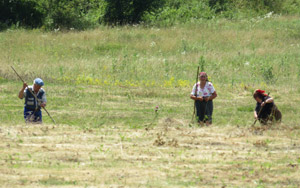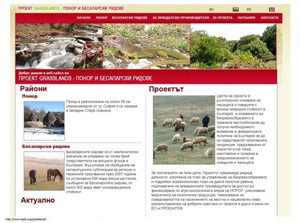Western Stara Planina region, Bulgaria
 Low intensity arable land and orchards
Semi-natural pastures and meadows
Ancient and coppiced forests
Calcareous grasslands
Mountain hay meadows
Nardus grasslands
Depopulation and land abandonment
Governance and regulation
Quarrying & illegal logging
Grazing pressure
Hard living and working conditions
Lack of collaboration with farmers
Online sales of HNV-raised beef
“Food from the Mountains” Association
Mobile advisory teams for HNV farmers
Natura 2000 measure to support HNV farmers
Low intensity arable land and orchards
Semi-natural pastures and meadows
Ancient and coppiced forests
Calcareous grasslands
Mountain hay meadows
Nardus grasslands
Depopulation and land abandonment
Governance and regulation
Quarrying & illegal logging
Grazing pressure
Hard living and working conditions
Lack of collaboration with farmers
Online sales of HNV-raised beef
“Food from the Mountains” Association
Mobile advisory teams for HNV farmers
Natura 2000 measure to support HNV farmers

Mosaics of low-intensive arable land and orchards near settlements are found in the lowlands. Grazing takes place on fallow land and crop residues. In many places, these areas are adjoined to riparian forests, meadows, marshland or coppice.

Important habitat for EU priority bird species: e.g. saker falcon (Falco cherrug), short-toed (Circaetus gallicus) and golden eagles (Aquila chrysaetos); wet meadow and shrubland birds (corncrake, Crex crex and rock partridge, Alectoris graeca, respectively). Vultures Neophron percnopterus and Gyps fulvus have disappeared due to decline sheep and, thus, carrion.

Half of the deciduous forest is beech (Fagus sylvatica and F. moesiaca). Coppice forests with oak (Quercus frainetto, Q. cerris, Q. dalechampii) and European hornbeam (Carpinus betulus) are omnipresent near settlements. The coniferous forests include pine plantations as well as ancient spruce forests (Picea abies).

Semi-natural dry grasslands on calcareous substrates are the most widespread grassland type in the low- and mid-mountain zones and are traditionally used for pasturing, with mowing taking place on semi-dry soils. Xerothermic grass communities are important for orchids and are classified as priority conservation habitat.

Located between 1000m and the tree line. These have good forage qualities and a vegetation period of up to 6 months. Their deep soils provide good nesting opportunities for the European souslik (Spermophilus citellus) and its predator the marbled polecat (Vormela peregusna peregusna).

Most widespread grassland type in the high mountains. Nardus grasslands occur above the tree line on siliceous, dry and poor soils, with large areas dominated by mat-grass (Nardus stricta). Nardus grasslands have great floristic diversity. Grazing at low stocking densities is necessary to maintain the habitat.

The main challenge for the area is rapid depopulation, aging population and lack of a qualified workforce in agriculture. In 2010, over 46% of the farmers in the learning area were over 64 years old, and 26% were 55-64 years old.

Frequent changes in legislation and support measures are challenges for the livestock farmers. Minimum yield requirements for sheep are higher than what farmers are currently able to achieve. Direct sales, including of plant products, is hindered by lack of processing units and bureaucratic procedures.
Forests, including ancient forests, are threatened by quarrying, unsustainable forest management, massive illegal logging, as well as plans for large-scale ski resorts.

In the calcareous dry meadows, abandonment and undergrazing resulted in scrub invasion by dog rose (Rosa canina), blackberry (Rubus), hawthorn (Crataegus), wild pear (Pyrus communis) and the subsequent loss of the habitat. Depending on their proximity to settlements, mesophilic hay meadows face abandonment, undergrazing or overgrazing.

The region is the most underdeveloped in the EU. Infrastructure and services are poor, the workload of the farming is high and dependent upon manual labour. There is a lack of continuity between the generations for the farming due to lack of interest in agriculture. Specifically, there is a shortage of reliable shepherds/herders.

Cooperation and support between farmers and administration is limited. Few farmers, especially small-scale, pro-actively seek new information and advice, hence they lack knowledge on legal requirements and changing requirements. Agriculture authorities’ and/or research institutes’ information dissemination is lacking– placing information on a website is insufficient.

Linbul Farm’s owners are new farmers that have garnered in-depth knowledge of HNV farming through a combination of practice, advice from researchers and studying online materials. Their cattle sustainably graze the alpine HNV grasslands through rotational grazing. They sell their beef to customers in the capital and surrounding area.

Nine diverse HNV farming practitioners founded the organization to promote their region as an area of alternative tourism offering clean food, traditional products, food and wine tasting, and guided tours. All aim to preserve the natural resources on which their businesses depend. The association is searching for funding for marketing.

During 2007-2011, the Bulgarian Society for the Protection of Birds (BSPB) operated two mobile advisory teams for HNV farmers in Western Stara Planina and Bessaparski Hills Important Bird Areas. Over 200 farmers received advice on HNV farming, funding opportunities, preparation of business plans, compliance with EU dairy standards, and marketing.

Designed for Natura 2000 sites for protection of wild birds (SPAs). The payments compensate farmers for specific land use restrictions favorable for birds. Farmer commitment is annual, and agriculture land in most SPAs in Bulgaria is eligible for this measure even if it is not eligible for direct payments.
Western Stara Planina is located in northwestern Bulgaria on the border with Serbia. The area is predominantly mountainous, with the land in the learning area (LA) equally divided between forests (48%) and agriculture (47%). HNV farmlands are found in the lowlands and high mountains. Western Stara Planina LA covers five municipalities across an area of 1662 km2. It hosts biodiversity richness of national, European and global importance and has seven areas designated as Natura 2000 sites. The region is the most economically depressed in Bulgaria, with challenges of underdevelopment and depopulation. However, local farmers and environmental NGOs have co-created innovative HNV farming initiatives. For more information on the area, see the Baseline Assessment
LA innovations:
- Bulgaria_RDP Natura 2000 measure for agricultural land
- Linbul farm
- Farmers association ”Food from the mountain”
- Mobile advisory teams
- Innovations (in Bulgarian)
Relevant for Western Stara Planina region from other areas:
- Spain: Quered association for artisan cheesemakers
- Spain: Finca Casablanca Dehesa farm developing a sustainable model
- France: Collective approaches by breeders (example, Slaughterhouse managed by breeders)
- France: Innovative regional procedures
- Greece: Terra Thessalia - flexible governance
- Greece: Participatory guarantee system
- Croatia: Drystone walls
- Ireland: The Burren Programme A locally targeted hybrid AES
- Ireland: Locally tailored livestock feeding and watering systems
- Ireland: Adding value to HNV farming
- Portugal: A healthy soil as the core of the Montado production system
- Romania: Integrated management plan
- Romania: PDO Telemeaua de Ibanesti
- Sweden: Mobile abattoir
- Sweden: FOCLUM
- The UK: Dartmoor Farming Futures
Other Downloads:
- Baseline Assessment
- All innovation work in the LA
- Report from the Innovation seminar
- Innovation report
Contact person: , Society for Territorial and Environmental prosperity (STEP), Bulgaria
Photographs ©HNV-Link, courtesy of Yanka Kazakova, Vyara Stefanova & Eva Vasileva; Map by Yanka Kazakova Screenshots: Linbul Facebook, Bulgarian Society for the Protection of Birds (http://bspb.org/bg/news/Nova-Internet-stranitsa-v-semeystvoto-na-BDZP.htm)
(July 2018)

